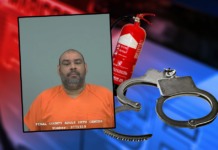
Brady Leffler said he was 24 years old when he made the decision to change his career.
The young Leffler, now 54, saw his salary cut in half when he left his job at Motorola to become a firefighter.
“And I don’t regret it one bit,” he said.
Fast-forward 30 years. The city of Maricopa, also, seems appreciative of the decision. Two months after being hired interim fire chief, Leffler got the nod from city management to take off the “interim” title on Nov. 18 and officially join the team.
In a short amount of time, Leffler, the husband of a United Express airline pilot and father of three, has made changes to the agency he believes will help improve the city’s fire service.
The new chief’s focus — something he started preaching before he took up the mantle permanently — is what he calls “a community-based fire service.”
“I want them to engage with the public at every level,” he said. “We are public servants. We are professional firefighters and I expect professional-level service. That’s what the public pays for, and that’s what I want them to get.”
When he came to the department, Leffler said he noticed a “void in the operational readiness of the agency.”
“In my opinion, that was due in large part to the organizational structure,” he said.
In early November, the city council approved a new chain of command structure for the department. The process already has begun to create three assistant fire chief positions, which will be accomplished through reclassifying two division chief positions and adding one more full-time position. The assistant chiefs will each oversee one of three areas: resources management, operations and community services.
“They had a fire chief. They had a division chief over prevention, and they had a division chief over support services,” Leffler said. “The one they were absolutely missing was an operational chief.”
Leffler said that position requires a person who focuses on, among other things, operational preparedness, or making sure crews are ready and properly equipped for certain emergencies.
The new chief said when he first got to the department he focused on making sure the agency was prepared to handle “target hazards,” or sites that have a high risk of a major emergency taking place. The Pinal Energy ethanol plant and the railroad that runs through the city are just two examples of such target hazards.
The new organizational chart also marks down future deputy chief positions, which are currently unfunded. Leffler said the idea was to prepare for the city and department’s future growth.
“Now I certainly can’t fund those and I can’t fill them, but I would venture to say that if the city goes the direction I think it’s going to go, there will be a day when I can do that,” he said. “So I wanted to set the tone now … so they can see this is how it will look down the road.”










![Merging lanes incite more 347 anger A merging lane sign sits on the side of State Route 347 northbound lanes during evening traffic on April 30, 2024. [Monica D. Spencer]](https://www.inmaricopa.com/wp-content/uploads/2024/04/spencer-043024-adot-merging-lanes-347-web-218x150.jpg)




